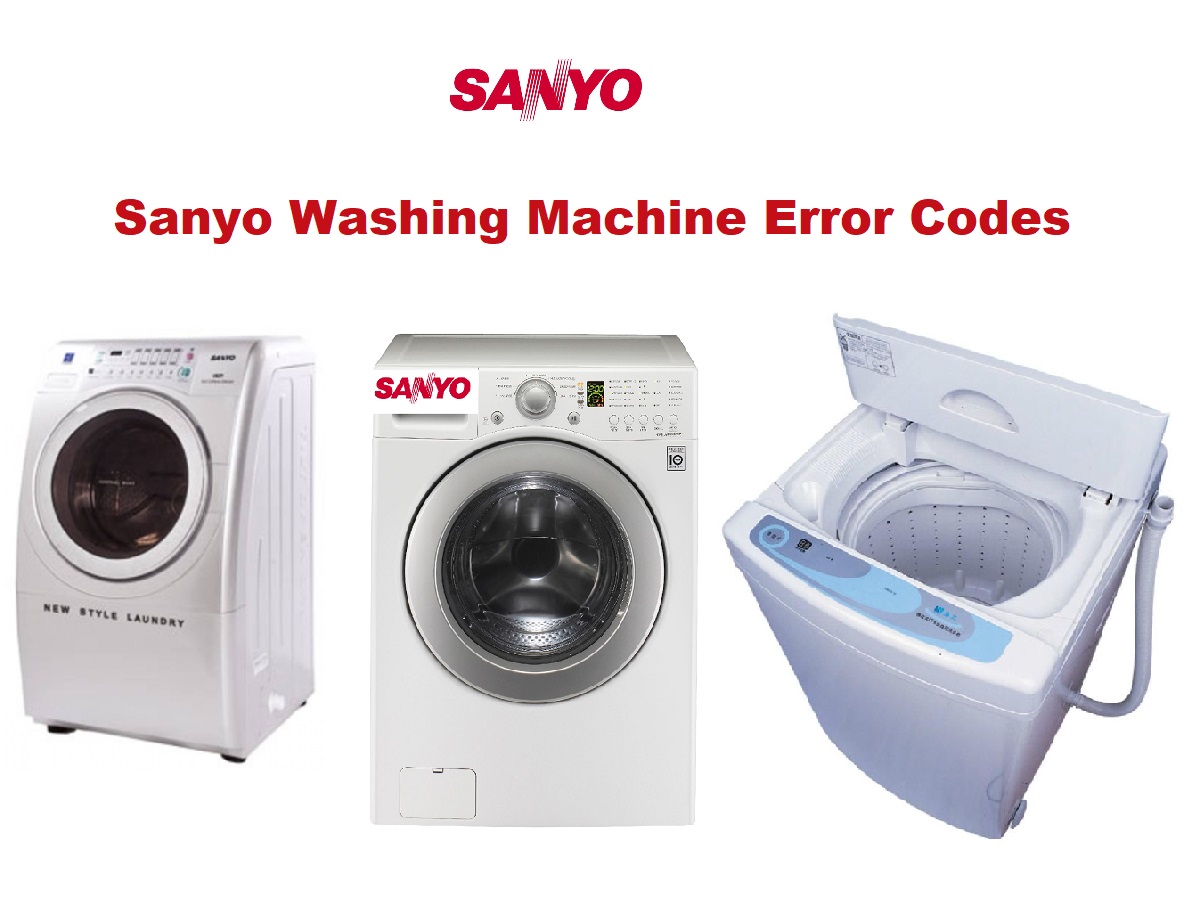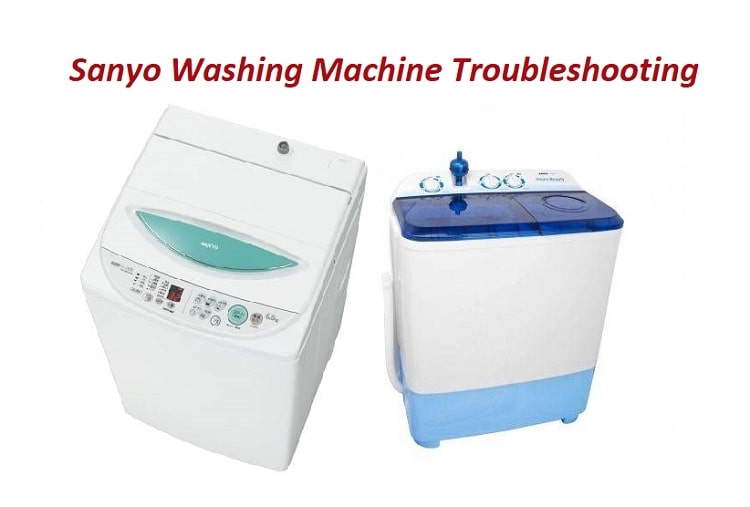
Sanyo Washing Machine Error Codes
| Error Codes | Problem |
|---|---|
| U4 | The washer does not spin. Close the Washer Lid. |
| U3 | The washer does not spin. |
| U5 | Does not wash. Check whether the Child safety mode is set or not. Close the Washer Lid. |
| E1 | Water does not flow into tub or water flow is slim. . |
| E2 | Water does not drain out. |
| EA | Press the START/ PAUSE button or turn the POWER SWITCH. |
| EC | Press the START/ PAUSE button or turn the POWER SWITCH. |
| EH1 | Power supply problems; PCB faulty. Wait for frequency nominal conditions. |
| EH2 | Power supply problems; PCB faulty. Wait for voltage nominal conditions. |
| EH3 | Power supply problems; PCB faulty. Wait for voltage nominal conditions. |
NOTE: The Trouble indicators can be released by pressing the START/PAUSE button once if you want to release the emergency stop. Then press the START/PAUSE button again to restart the operation.

Troubleshooting

Trouble: Abnormal (Squeaky) sound is heard during washing
Symptom: The squeaky sound occurs when the brake system operates. During washing, the Pulsator turns CW (clockwise) and CCW (counterclockwise), producing water flow in the CW and CCW direction. The water flow exerts force on the Spin Tub in the same directions though interlocked with the Brake Wheel during washing. The Spin Tub turns a little if the friction with the brake lining reduces, generating braking sound. This symptom will not arise due to use of long duration but is entirely an initial fault.
Diagnosis: Turn off the power. Open the Washer Lid. Hold the Spin Tub and lightly turn it CW. If sound is heard from the brake, it is defective.
Cause: The cause can be limited to foreign substance (grease in particular) affixed to the surface of brake lining and brake wheel, which is attributed to poor quality control in the Bearing Assembly manufacturing process.
Handling: Replace the Bearing Case (complete) and wipe the Brake Wheel surface with alcohol.
Trouble: Spin tub stops sound (squeak)
Symptom: Squeaky sound is heard immediately before the Spin Tub stops.
Cause: This symptom often arises when friction factor between brake lining and brake wheel is too big. Therefore, this occurs when brake time is short, the cause of which is attributed mainly to the improperness of brake lining material, roughness of brake wheel surface and excessive strength of brake spring, but attachment of foreign matter and high humidity can also be responsible for the symptom.
Diagnosis: Allow water extraction program to complete automatically instead of forcibly, apply the brake, and listen for squeaky sound when the Spin Tub stops.
Handling: Replace the Bearing Case (complete) and wipe the Brake Wheel surface with alcohol.
Trouble: Brake does not work
Symptom: Brake is applied when water extraction has completed, but the Spin Tub takes too long time to come to a complete stop.
Cause: Braking torque is too small, which is attributed to excessive abrasion of brake lining, attachment of foreign substance (grease in particular) on the surface of brake wheel and brake lining, etc..
Diagnosis: Taking approx 10 sec. of braking time, which is normally about 5 sec, can be determined to be defective.
Handling: Replace the Bearing Case (complete) and wipe the Brake Wheel surface with alcohol.
Trouble: Abrupt braking (When the Spin Tub stops, the entire machine moves)
Symptom: Brake is applied when the water extraction has complete, but the Spin Tub takes a very short time to come to a complete stop.
Cause: Braking torque is too big, which is attributed to abnormal shape of brake lining. This symptom occurs particularly when clearance between brake lining and brake wheel is too small at their tips.
Diagnosis: Taking only 2 or 3 sec. of braking time, which is normally about 5 sec at no load, can be determined to be defective.
Handling: Replace the Bearing Case (complete) and wipe the Brake Wheel surface with alcohol.
Trouble: Spin tub does not rotate (Spin Tub is locked)
Symptom: Spin Tub does not rotate despite water extraction starting stage.
Cause: When it is caused by electric signals, water level sensor, Magnetic Coil, motor receptacle Housing Assembly, PCB Complete, Safety Switch, etc are likely to response. However, the troubles are mainly caused by related mechanical parts in this case. If this problem occurs, the clutch mechanism of Bearing Ass y will fail. Especially, one-way bearing, which composes part of Bearing Case (complete), rusted by detergent penetrating is the main cause of the trouble. Insufficient transfer of rotation due to inaccurate dimensions of clutch spring also causes the trouble.
Diagnosis: Assuming that all electric parts are normal, check if the Spin Tub can be easily rotated by hand when the Magnetic Coil is in the state of pulling
Handling: Replace the Bearing Case (complete) and wipe the Brake Wheel surface clean with alcohol, or replace the Clutch Spring.
Trouble: Water leakage
Symptom: Water leaks from somewhere around the Bearing Ass y. Parts of the Bearing are sometimes seen rusted.
Cause: Oil seal lip lying on the top of ring (complete) is insufficiently fitted in the Outer Tub Bottom.
Handling: Replace the Bearing Ass’y.
Trouble: Click sound is heard during washing
Symptom: Click sound is heard from the vicinity of the Bearing Ass y. Similar sound can also be caused by a small metal piece, such as a coin or hair pin penetrating into the back of the Pulsator, damaging and making its rear ribs into flakes and resultantly generating sound. This will not be discussed here because there is nothing to do with the Bearing Ass’y.
Cause: Infusion engagement of the Clutch Lever with the ratchet causes the lever to jump, making noises. In the washing process, the Clutch Lever is normally engaged with the ratchet completely, generating no sound.
Diagnosis: Normally the clearance between the circumference of the ratchet and clutch lever is approximately 3 mm. In the event of this trouble, the clearance should be 5 to 6 mm.